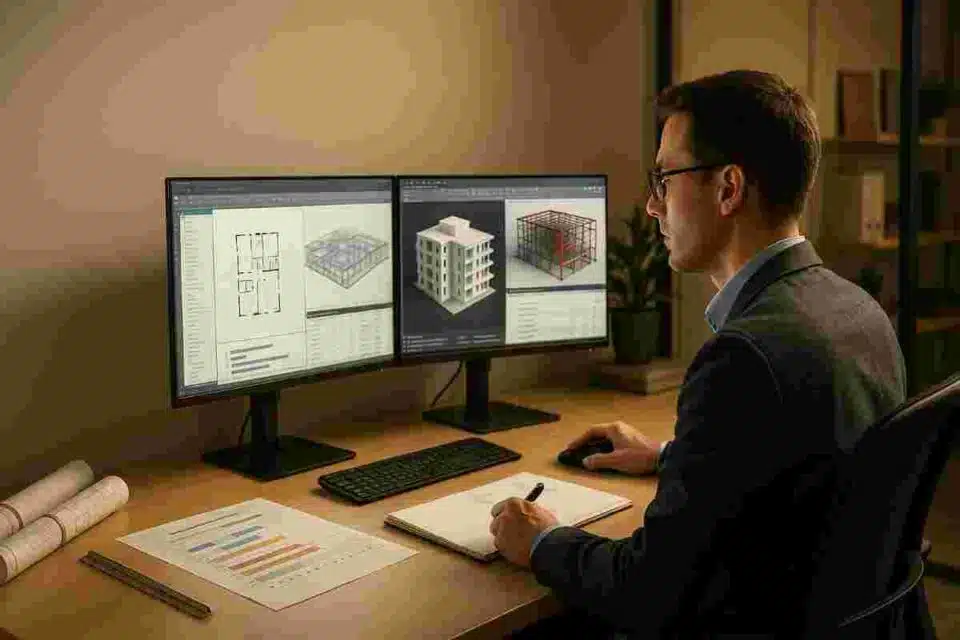Last Updated on September 18, 2025 by Admin
The construction industry is experiencing a significant shift as BIM managers increasingly seek alternatives to Autodesk Revit. With rising subscription costs reaching $3005 annually and persistent user experience issues, many firms are exploring software that delivers better value, improved usability, and specialized capabilities. Our research across professional forums, industry surveys, and comprehensive software analysis reveals that viable alternatives can reduce software costs by 40-70% while potentially improving productivity.
Table of Contents
Selection criteria and methodology
Our evaluation focused on software that meets the critical needs of U.S. BIM professionals: robust BIM capabilities, IFC interoperability, reasonable pricing, and strong learning resources. We prioritized platforms with proven track records in architectural, structural, or MEP workflows, emphasizing those with established U.S. market presence and support infrastructure. Each alternative was assessed based on parametric modeling capabilities, collaboration features, file format compatibility, total cost of ownership, and user community strength.
The research incorporated insights from verified user testimonials, professional forums like Reddit r/Revit discussions, and other relevant data, ensuring recommendations reflect real-world implementation experiences rather than marketing claims.
Practice 15+ AI-generated technical and HR interview questions for Civil, BIM, QS, Planning, HSE and Construction roles. Get instant feedback, improved answers, a 7-day improvement plan, and a full PDF report. Designed exclusively for construction professionals.
One free full interview session included. No credit card required.
Quick picks for busy BIM managers
- Best overall alternative: ArchiCAD offers the most intuitive transition from Revit with comprehensive BIM capabilities and exceptional user satisfaction ratings.
- Best value: BricsCAD BIM delivers solid BIM functionality for $1,060/year, less than half the cost of Revit.
- Best for residential: Chief Architect dominates residential design with automated building systems and extensive manufacturer libraries.
- Best for visualization: SketchUp Studio excels at conceptual design and presentation with included V-Ray rendering.
- Best open source: FreeCAD + BIM Workbench provides completely free BIM capabilities with growing community support.
Related Posts:
- A Beginner’s Guide to Revit Architecture Training: Unlocking Your Path to Architectural Mastery
- Alternative Careers for Civil Engineers in 2025: Unlock New Opportunities
- Integrating Smart Time Tracking For Improved Construction Workflows
- Navigating Equipment Financing Challenges with Poor Credit Scores
Detailed Revit Alternatives software reviews for 2025
1. ArchiCAD by Graphisoft
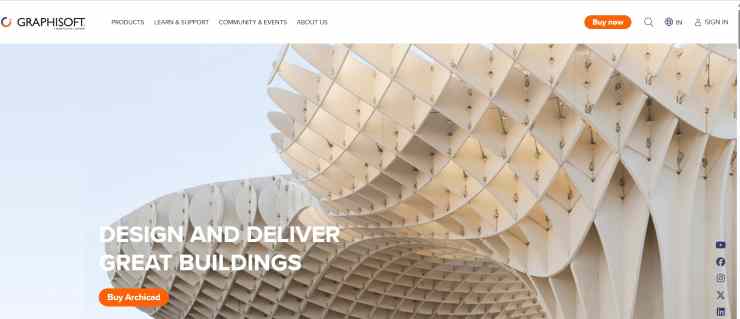
ArchiCAD consistently receives the highest user satisfaction ratings among Revit alternatives. Real users report that “using ArchiCAD is like dancing while Revit is more like wrestling,” highlighting the software’s intuitive design approach.
- Key strengths include exceptional ease of use, with architects praising its logical workflow that requires minimal training time. The software excels at 2D documentation quality and integrated visualization tools, while maintaining strong OpenBIM compatibility through excellent IFC support.
- Pricing starts at $78/month for the Studio subscription, with educational versions available free for students. The 30-day trial provides full functionality for thorough evaluation.
- Collaboration features through BIMcloud enable real-time multi-user editing with conflict resolution. The software integrates seamlessly with Enscape for real-time rendering and supports Grasshopper for algorithmic design.
- Best for: Architectural firms seeking the most user-friendly Revit alternative without sacrificing BIM capabilities.
2. Vectorworks Architect
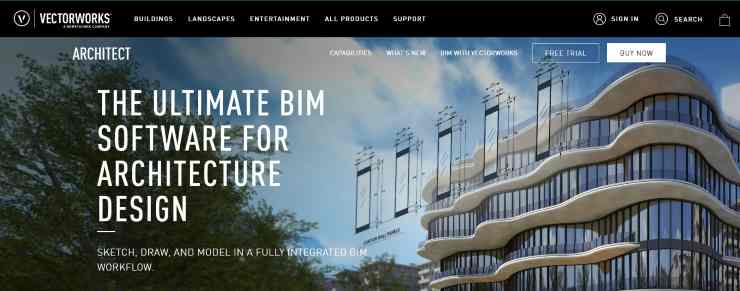
Vectorworks shines in design-focused workflows where creativity and flexibility take precedence. Users consistently praise its superior 2D drafting capabilities and exceptional Mac support, making it popular among design-oriented firms.
- The software excels at landscape integration and site design, offering versatility across architecture, landscape, and entertainment industries. Built-in Marionette visual scripting enables parametric design without coding knowledge.
- Annual subscriptions cost $127.5/month with strong educational discounts available. The software includes Shared Cloud Folders for collaboration and comprehensive training resources through Vectorworks University.
- Notable integrations include excellent Twinmotion support with live sync capabilities and built-in Cinema 4D rendering through Cineware integration.
- Best for: Design firms prioritizing creative flexibility and requiring cross-platform compatibility.
3. BricsCAD BIM

BricsCAD BIM offers exceptional value for firms transitioning from traditional CAD workflows. Users report a “smooth transition from CAD to BIM” thanks to its familiar DWG-native platform and AutoCAD-compatible interface.
- Unique advantages include Linux support, AI-driven BIM classification, and significantly lower costs at $1,060/year. The software provides robust parametric modeling while maintaining familiar CAD-style workflows.
- Collaboration occurs through standard file sharing and cloud services, with extensive API support for custom integrations. The 30-day trial requires no credit card for evaluation.
- Machine learning features automatically classify 3D geometry into BIM objects, reducing manual modeling time while maintaining accuracy.
- Best for: CAD users seeking BIM capabilities without abandoning familiar workflows and interface paradigms.
4. Chief Architect
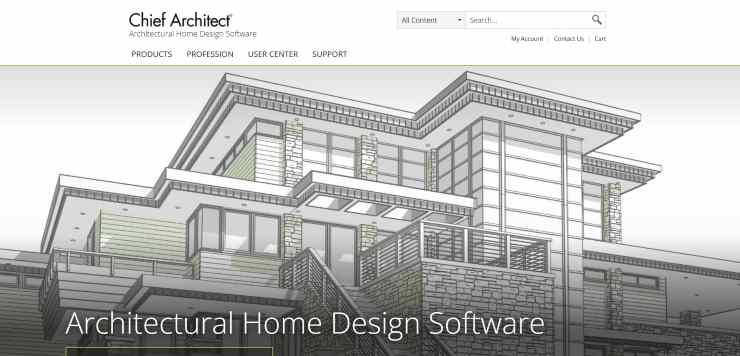
Chief Architect dominates residential design with automated building systems that save significant time in custom home and light commercial projects. Users praise its extensive manufacturer libraries and intelligent framing capabilities.
- Specialized residential tools include automated roof generation, foundation design, and comprehensive material lists for construction. The software excels at client presentations through photorealistic rendering and mobile sharing via the 3D Viewer app.
- Pricing at $166.25/month when paid annually positions it competitively for residential specialists. Strong U.S. market presence ensures local support and building code compliance.
- Integration with manufacturer catalogs provides direct access to actual building products, streamlining specification and procurement processes.
- Best for: Residential architects, custom home builders, and kitchen/bath designers requiring specialized residential tools.
5. SketchUp Studio
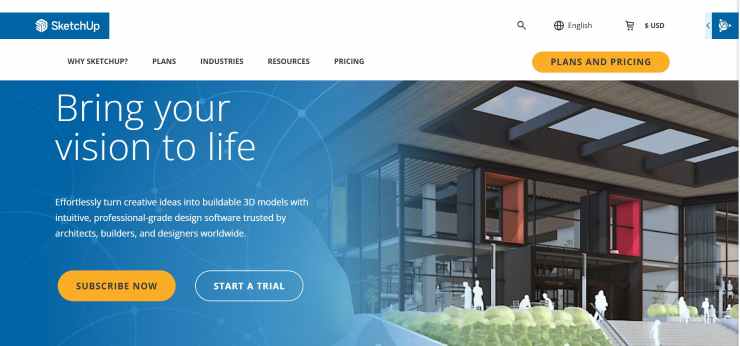
SketchUp Studio provides an excellent bridge between conceptual design and BIM workflows. The intuitive interface enables rapid design exploration with significantly shorter learning curves than traditional BIM software.
- Studio includes V-Ray rendering, point cloud support, and Revit import capabilities, making it valuable for visualization-heavy workflows. The extensive Extension Warehouse provides BIM functionality through third-party plugins.
- Annual subscriptions, from $10.75 USD to $68.25 per month / per user billed annually, offer excellent value for conceptual design and presentation work. Integration with Trimble Connect enables basic collaboration workflows.
- Reality capture capabilities through Scan Essentials support point cloud integration for existing building renovation projects.
- Best for: Conceptual design, visualization specialists, and firms requiring rapid design iteration capabilities.
6. Allplan Architecture — Detailing-focused BIM from Nemetschek
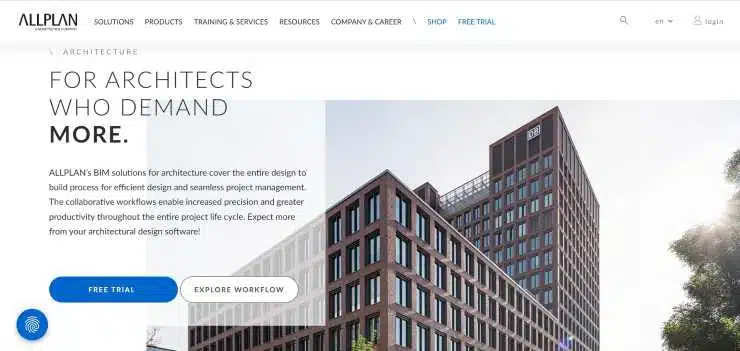
Allplan is a robust alternative with powerful modeling and documentation, plus Bimplus for CDE workflows. It supports IFC 2×3/IFC4 and standard CAD exchanges; Allplan also introduced a Revit import tech preview in prior versions. U.S. pricing is published on the Allplan shop; 14-day trials are available.
- Key features: Advanced documentation/detailing, architecture & engineering toolsets, Bimplus integration.
- Interoperability: IFC (2×3/4), DWG/DXF; Revit import (tech preview).
- Pricing (USD): ~$3,480/yr (Pro) to ~$4,704/yr (Ultimate); 14-day trial.
- Pros: Excellent documentation; Nemetschek ecosystem; strong IFC.
- Cons: Windows-only; some IFC workflows (e.g., rotations) have limitations reported by users.
- Best for: Architecture and engineering teams that need deep drafting/detailing with openBIM.
7. Tekla Structures
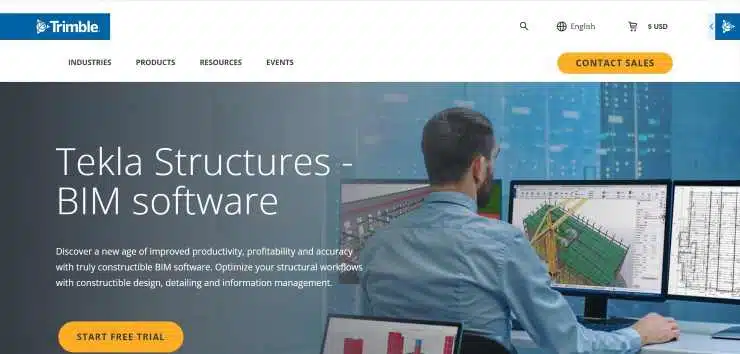
Tekla Structures represents the gold standard for structural steel detailing and fabrication. The software provides LOD 500 modeling capabilities with direct CNC machine output for steel fabrication.
- Advanced collaboration features include global team coordination and comprehensive change management. The software excels at complex structural projects requiring precise fabrication details.
- Pricing starts at $3,000-4,000 annually, with implementation costs potentially reaching $100,000 for large organizations. The steep learning curve requires significant training investment.
- Fabrication integration enables direct output to manufacturing equipment, streamlining the design-to-construction process for steel structures.
- Best for: Structural engineers and steel fabricators requiring the highest level of modeling detail and manufacturing integration.
8. Bentley OpenBuildings Designer

OpenBuildings Designer targets large-scale infrastructure projects with multi-disciplinary BIM capabilities in a single environment. The software excels at airports, rail stations, and complex mixed-use developments.
- Advanced features include integrated energy analysis, generative design capabilities, and robust reality modeling support. Strong interoperability within the Bentley ecosystem enables comprehensive infrastructure workflows.
- Subscription pricing starts at $1888 annually through Bentley’s Virtuoso program, including training credits and support services.
- ProjectWise integration provides enterprise-level collaboration and data management capabilities for large, distributed project teams.
- Best for: Large infrastructure projects requiring multi-disciplinary coordination and integration with reality capture data.
9. FreeCAD + BIM Workbench
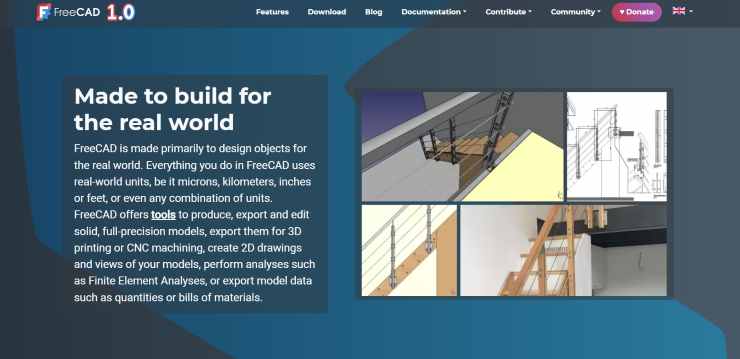
FreeCAD offers completely free BIM capabilities with excellent IFC compliance and cross-platform support. The open-source nature ensures no vendor lock-in and complete data ownership.
- Native BIM features include parametric walls, windows, doors, and structural elements with automated quantity takeoffs. The software supports all major platforms equally.
- Price: FREE
- Python scripting capabilities enable extensive customization and automation of repetitive tasks. The modular workbench system allows focus on specific disciplines as needed.
- Community-driven development ensures continuous improvement and user-focused feature development without commercial constraints.
- Best for: Educational institutions, small firms with technical expertise, and organizations requiring complete software independence.
10. BlenderBIM (Bonsai)

BlenderBIM represents cutting-edge open BIM technology with native IFC authoring capabilities. The software builds on Blender’s powerful visualization and animation tools.
- Advanced BIM features include 4D/5D capabilities, clash detection, and comprehensive quantity takeoffs. BCF support enables professional issue tracking and collaboration.
- Price: FREE
- True native IFC modeling eliminates translation errors common in traditional BIM software. The software leverages Blender’s extensive rendering and visualization capabilities.
- Steep learning curve requires understanding both the Blender interface and BIM concepts, making it suitable for technically sophisticated users.
- Best for: Advanced BIM research, educational institutions, and organizations committed to cutting-edge open BIM workflows.
11. Edificius
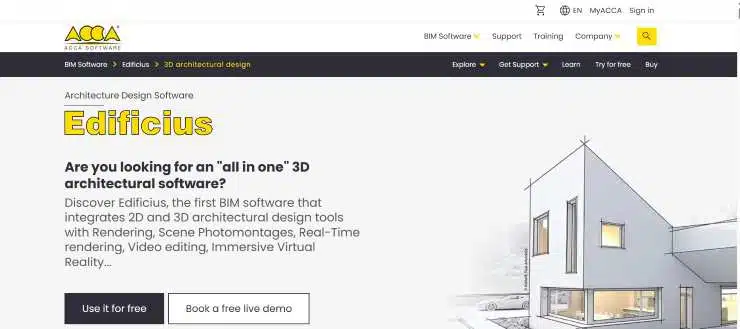
Edificius provides integrated BIM capabilities with built-in Unreal Engine rendering for real-time visualization. The software includes 5D cost estimation and project scheduling.
- Real-time rendering capabilities enable instant design visualization without external software. Smart MEP objects provide automated system connections and routing.
- Pricing starts at $58/month with flexible subscription options and educational discounts. The software integrates well within the ACCA software ecosystem.
- Limited U.S. market presence may affect support and training availability for North American users.
- Best for: Small architectural firms requiring integrated visualization and cost estimation capabilities.
Buying guide for BIM managers
Firm size considerations
- Small firms (1-20 employees) should prioritize ease of use and cost-effectiveness. ArchiCAD, Chief Architect, or BricsCAD BIM offer the best value propositions with manageable learning curves for emerging BIM professionals.
- Medium firms (20-50 employees) require balanced capabilities and collaboration features. Vectorworks and ArchiCAD provide excellent scaling options with robust teamwork capabilities that support growing BIM teams.
- Large firms (50+ employees) need enterprise-level collaboration and standardization. Consider pilot programs with alternatives while maintaining Revit for complex multidisciplinary projects involving specialized BIM management roles.
Technical requirements
- Windows-only environments can choose from all alternatives, while Mac users should focus on ArchiCAD, Vectorworks, or FreeCAD for full native support according to platform compatibility analysis.
- Cloud collaboration needs to favor ArchiCAD’s BIMcloud, Vectorworks’ cloud folders, or SketchUp’s Trimble Connect integration for distributed teams.
- Legacy CAD data integration works best with BricsCAD BIM’s native DWG support or tools with strong DWG import capabilities for seamless workflow transitions.
Implementation strategies
- Pilot project approach allows risk-free evaluation of alternatives on smaller projects before organization-wide adoption, following industry best practices.
- Hybrid workflows enable a gradual transition while maintaining interoperability with Revit-using consultants through strong IFC support and buildingSMART compliance.
- Training investment varies significantly – budget 2-6 months for team proficiency, depending on software complexity and current skill levels.
The verdict on Revit alternatives
The BIM software landscape in 2025 offers genuine alternatives that address Revit’s pain points while providing unique strengths. ArchiCAD emerges as the strongest overall alternative, combining intuitive workflows with comprehensive BIM capabilities and strong user satisfaction ratings documented across professional communities.
For specialized needs, Chief Architect dominates residential design, while Tekla Structures remains unmatched for steel fabrication. Cost-conscious firms should seriously consider BricsCAD BIM or open-source options like FreeCAD for budget-optimized implementations.
The key to successful implementation lies in matching software capabilities to specific firm requirements rather than seeking a universal replacement. Many successful firms adopt hybrid approaches, using specialized tools for specific workflows while maintaining interoperability through strong IFC support.
As industry testimonials consistently demonstrate, the right alternative can significantly improve productivity while reducing software costs. The current market conditions create an excellent opportunity for BIM managers to evaluate alternatives and potentially achieve substantial improvements in both user satisfaction and operational efficiency.
For professionals considering career transitions or skill development, exploring diverse BIM tools opens doors to specialized opportunities in the growing digital construction market. The software choices you make today will shape your team’s capabilities and competitive positioning in an increasingly technology-driven industry.
Related Content:
Frequently asked questions
Yes, most alternatives support IFC files for model exchange and coordination with Revit projects. ArchiCAD and Vectorworks offer particularly strong interoperability for mixed-software project teams.
While direct family import is limited, most alternatives include extensive built-in libraries and support manufacturer content. SketchUp Studio can import Revit files directly, providing transition flexibility for visualization workflows.
Training costs range from $200 to $15,000 per employee, depending on software complexity. ArchiCAD and Chief Architect generally require less training investment than Tekla or Bentley products, making them cost-effective choices for most firms.
FreeCAD and BlenderBIM offer genuine BIM capabilities at no cost, though they require significant technical expertise and learning investment suitable for advanced BIM professionals.
Most alternatives follow subscription models, though BricsCAD still offers perpetual licenses. Factor in training and support costs when comparing total ownership costs for comprehensive budget planning.
Software like ArchiCAD, Vectorworks, and Tekla Structures provides robust MEP and structural capabilities. Specialized MEP professionals should evaluate discipline-specific features during software selection.
ArchiCAD, Vectorworks, and FreeCAD offer full native Mac support with feature parity to Windows versions, according to user reviews and technical specifications.


